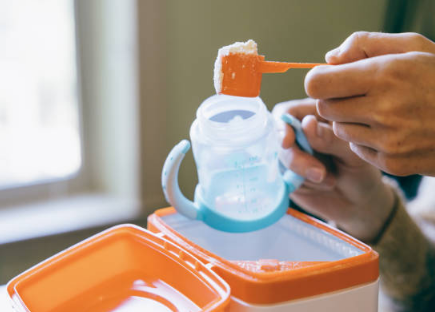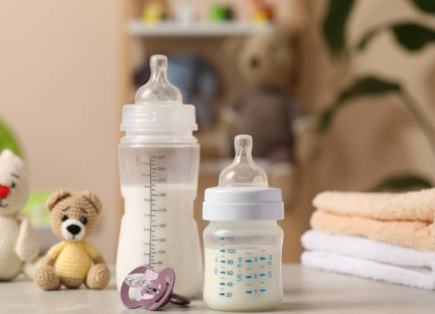No matter how many books you read, how many movies you watch, or how many birthing classes you take, there’s no way to prepare you for the moment you feed your baby for the first time. The feeling of watching them eat until their little belly is full, whether breastfed or bottle-fed.
The American Academy of Pediatrics (AAP) and the World Health Organization (WHO) recommend exclusive breastfeeding for the first six months of a baby’s life, with complementary foods starting at 6 months and then according to the wishes of parents and infants.

However, for some parents and infants, exclusive breastfeeding may not be possible, and formula milk is a healthy and safe alternative, either alone or in combination with breast milk. The good news is that the benefits of breastfeeding are not all or all.
Here, experts weigh knowledge about the mix of breast milk and formula milk, as well as risks, benefits, and safety precautions.
When Mixing Breast Milk and Formula Makes Sense
Mixed feeding is when breast milk and formula are alternately fed, or when breast milk and formula are mixed in the same bottle. While the benefits of breast milk are well known, there are instances where parents simply cannot provide enough breast milk to meet their baby’s needs. There are many reasons why parents mix feeding their babies. If someone else takes care of your baby while you work during the day, you may choose to mix feeding. You may also be running low on your milk supply, but you still want to breastfeed.
“In these cases, I think any breast milk is better than no breast milk,” explains Emily Wisniewski, MD, a pediatrician at Mercy Family Care in Baltimore. “Rather than having a family give up altogether and switch to formula, using both allows the baby to reap some of the benefits that breast milk provides, while getting the same volume that the baby needs to grow. ”
Premature babies may also benefit from a combination of breast milk and formula. Jeanine Hoelsken, a nursing nurse at Children’s Hospital in Colorado, said the hospital often provides formulas with special additives for babies with complex illnesses and substitutes breastfeeding with breast milk.
In addition, parents transitioning from breast milk may choose to mix breast milk with formula milk to extend the time their baby gets breast milk while reducing the supply of breast milk.
Can Breast Milk and Formula Be Mixed in the Same Bottle?
If the bottle is prepared correctly, the short answer is yes. Dr. Wisniewski says it’s crucial to follow the formula manufacturer’s instructions when adding formula to breast milk, and always check with your pediatrician’s or provider’s office before making changes to your baby’s diet.

Mix breast milk and ready-to-eat formula
Dr. Wisniewski explains that the easiest way to mix breast milk and formula in the same bottle is to start with ready-to-eat or pre-mixed liquid formula. Just put them in a bottle and shake them well.
Mix breast milk and formula
Start by preparing the powder recipe according to the instructions. Dr. Wisniewski says that breast milk should never be used instead of water to mix formula. Doing so, she explains, can upset the nutritional balance and can be dangerous for your child. Once the formula is ready, add breast milk to achieve the desired amount.
Benefits of Mixing Breast Milk and Formula
For people who are breastfeeding or having difficulty pumping, mixing breast milk and formula allows babies to reap the benefits of breast milk while ensuring they are getting enough nutrients to thrive. It can also help make the transition from breast milk easier if the parent is going back to work or the baby is being cared for by another person (or any other reason).
Mixing the two in the same bottle also allows you to utilize stored breast milk for longer. According to the CDC, you can freeze breast milk for up to 12 months if the temperature is at or below 0°F.
Risks of Mixing Breast Milk and Formula
Although it is safe to mix breast milk and formula in the same bottle, Holsken recommends feeding separately. That way, if your baby doesn’t finish eating, you won’t waste breast milk. The goal should be to save every drop of breast milk as much as possible, especially if you’re struggling to pump breast milk into a bottle, Holsken says.
Adding formula to your baby’s diet may also cause you to breastfeed or pump less, reducing your supply. Dr. Wisniewski explains that adding breast milk to a bottle may not be safe for babies who use hypoallergenic or amino acid formulas if there is a problem in their parents’ diet.
How to Store Mixing Bottles Safely
Dr. Wisniewski says that if the bottle contains breast milk and formula, you should follow the CDC’s guidelines for safe formula storage. According to guidelines, it is safe to use formula within two hours of preparation and within one hour of initiation of feeding. If the bottle is not already in use, you can store it in the refrigerator for up to 24 hours.
Throw away any bottle residue that exceeds the recommended time frame, as the combination of the baby’s saliva and formula can cause bacterial growth.
